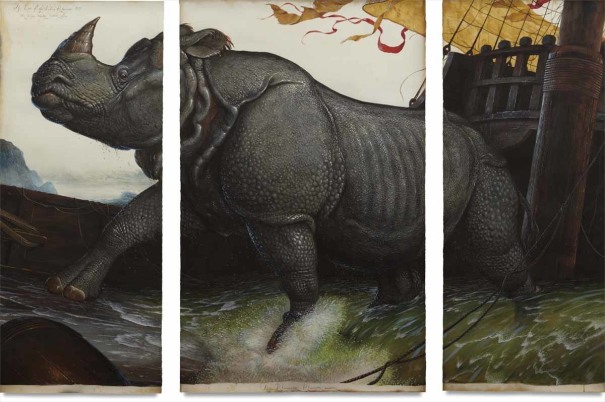Walton Ford Guilty Elephant 1994 oil on panel 63 x 46 in. (160 x 116.8 cm) Signed, titled and dated "Walton Ford, Guilty Elephant, 1994" on the reverse.
Provenance Paul Kasmin Gallery, New York Acquired from the above by the present owner Catalogue Essay Endowing meticulously-rendered natural scenes with melodramatic and ethical consequence, Walton Ford is a singular force in contemporary art. Inspired by countless visits to the Museum of Natural History in New York, Ford leverages a scientific visual language in order to reveal the problematic colonial narratives that underlie contemporary existence. Nineteenth-century zoologist and illustrator John James Audubon is Ford’s principal inspiration. Like Audubon, Ford depicts his subjects with a remarkable anatomical clarity. In Guilty Elephant, 1994 he captures a wide array of animal characters and botanical species. The composition is bordered by a frame of abounding flora. Twisting vines, ivory flowers and emerald leaves encircle the principal scene. The work is decorated throughout with anecdotal detail, including a scarlet parrot as well as a pair of curling serpents. Through this mass of flourishing life, the viewer is granted hazy access to an unsettling scene. An elephant, a motif prominent throughout Ford’s work, stands amidst a scattered group of dark figures. Obscure architectural references indicate signs of civilization, and billows of smoke hang portentously in the air. In Guilty Elephant, human presence upsets the sublimity of Ford’s natural universe. The relationship between the natural world and human influence is continually present in Ford’s painting. He reflected on his artistic vocation, “What I’m doing…is building a sort of cultural history of the way animals live in the human imagination.” (W. Ford quoted in C. Tomkins “Man as Beast,” The New Yorker, New York, January 26, 2009). Guilty Elephant is loaded with allegorical significance. Through the language of colonial-era history painting, Ford meditates on the relationship between the natural world and human kind. It is a theme that holds vital consequence to this day. Critic Calvin Tompkins writes, “Ford readily concedes that Audubon is the cornerstone of his own work, but, to me, Ford's conceptual wilderness--the tension between nature and culture, fornication and extinction, the animal and the human--makes him contemporary in ways that Audubon could hardly have imagined.” (C. Tompkins, The New Yorker, January 6, 2009, p. 55). Markedly different than his artistic peers, Ford reinvigorates a historical language for entirely new purposes. As an artist, he calls into question the very character of contemporary art. Read More
Walton Ford Guilty Elephant 1994 oil on panel 63 x 46 in. (160 x 116.8 cm) Signed, titled and dated "Walton Ford, Guilty Elephant, 1994" on the reverse.
Provenance Paul Kasmin Gallery, New York Acquired from the above by the present owner Catalogue Essay Endowing meticulously-rendered natural scenes with melodramatic and ethical consequence, Walton Ford is a singular force in contemporary art. Inspired by countless visits to the Museum of Natural History in New York, Ford leverages a scientific visual language in order to reveal the problematic colonial narratives that underlie contemporary existence. Nineteenth-century zoologist and illustrator John James Audubon is Ford’s principal inspiration. Like Audubon, Ford depicts his subjects with a remarkable anatomical clarity. In Guilty Elephant, 1994 he captures a wide array of animal characters and botanical species. The composition is bordered by a frame of abounding flora. Twisting vines, ivory flowers and emerald leaves encircle the principal scene. The work is decorated throughout with anecdotal detail, including a scarlet parrot as well as a pair of curling serpents. Through this mass of flourishing life, the viewer is granted hazy access to an unsettling scene. An elephant, a motif prominent throughout Ford’s work, stands amidst a scattered group of dark figures. Obscure architectural references indicate signs of civilization, and billows of smoke hang portentously in the air. In Guilty Elephant, human presence upsets the sublimity of Ford’s natural universe. The relationship between the natural world and human influence is continually present in Ford’s painting. He reflected on his artistic vocation, “What I’m doing…is building a sort of cultural history of the way animals live in the human imagination.” (W. Ford quoted in C. Tomkins “Man as Beast,” The New Yorker, New York, January 26, 2009). Guilty Elephant is loaded with allegorical significance. Through the language of colonial-era history painting, Ford meditates on the relationship between the natural world and human kind. It is a theme that holds vital consequence to this day. Critic Calvin Tompkins writes, “Ford readily concedes that Audubon is the cornerstone of his own work, but, to me, Ford's conceptual wilderness--the tension between nature and culture, fornication and extinction, the animal and the human--makes him contemporary in ways that Audubon could hardly have imagined.” (C. Tompkins, The New Yorker, January 6, 2009, p. 55). Markedly different than his artistic peers, Ford reinvigorates a historical language for entirely new purposes. As an artist, he calls into question the very character of contemporary art. Read More















Testen Sie LotSearch und seine Premium-Features 7 Tage - ohne Kosten!
Lassen Sie sich automatisch über neue Objekte in kommenden Auktionen benachrichtigen.
Suchauftrag anlegen